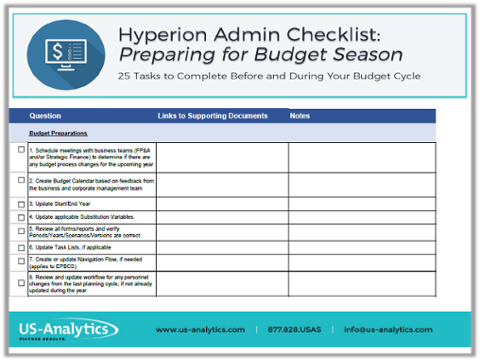If you’re an FP&A professional at a large company, chances are you’re faced with a long budget cycle that takes several months to complete. In this blog post, we’ll talk about five common culprits of a slow planning cycle and the steps you can take to get to faster (and more accurate) results.
Lack of automation
Many business and finance leaders agree that Excel spreadsheets are extremely useful and can help with performing complex forecasting functions. However, manual methods create delays with the time it takes to input data, make corrections across multiple spreadsheets, and reconfigure sheets that are returned in a different format by the many people across the enterprise who edit and manipulate the data. And the Excel spreadsheet shuffle not only slows down processes — it invites error. (Learn more in our white paper, Beware: Excel for Planning, Budgeting, and Forecasting.)
Planning software like Hyperion Planning or Oracle Planning & Budgeting Cloud Service leverage the familiarity of Excel while eliminating the pitfalls. Hyperion Planning is most often used in conjunction with Essbase, which extracts and aggregates data from a wide range of sources. Essbase stores data in a cube and calculates your data, providing fast access to results.
Decentralized data
Using Excel for planning and forecasting means your data is siloed into individual business units. Data from one spreadsheet might rely on data from another, significantly slowing your planning cycle.
Decentralized data can create havoc for other business units who need the data so they can plan accordingly. An EPM solution like Hyperion Planning allows various business units to plan in different ways for optimal results — and a faster planning cycle.
Metrics that don't match your strategic or operational goals
Driver-based planning is a buzzword, but for good reason. Traditional planning methods typically don’t align with your organization’s strategy or operations. Driver-based planning, however, focuses on your inputs, not your outputs — meaning that you’re focused on the key metrics driving your business rather than the dollar amount.
With driver-based planning, you work backwards, focusing on the key metrics that are important to your company’s strategic and operational goals. This will help increase transparency and help speed up your planning cycle, since you’ll know which metrics to focus on.
Too many details
A huge slowdown in your planning cycle is adding too much detail, which can cause an overload of information. A good rule of thumb is to focus on greater details for short-term planning, and less detail when you’re forecasting further into the future.
Conversely, you should ensure you provide enough detail for large cost items or volatile revenue components.
A stagnant forecasting model
The traditional method of budgeting and forecasting causes you to spend months on a forecast that quickly becomes outdated. Then, trying to reforecast in response to market fluctuations isn’t really feasible. You end up spending time on something worthless and scrambling later on.
Using rolling forecasts doesn’t just speed up your planning cycle, it makes your forecasting model a living document. There are many advantages of continually forecasting — you become more agile in response to changes or trends, and your information is more accurate.




![5 Barriers That Slow Your Planning Cycle [Free Checklist]](http://www.us-analytics.com/hubfs/5%20Barriers%20in%20the%20Planning%20Cycle.jpg)


